Archduke Joseph August of Austria
Last updatedYou can help expand this article with text translated from the corresponding article in Hungarian. (November 2012)Click [show] for important translation instructions.
|
| Archduke Joseph August | |||||
|---|---|---|---|---|---|
| Palatine of Hungary (titular) | |||||
 | |||||
| Regent of Hungary | |||||
| In office 7 August 1919 –23 August 1919 | |||||
| Monarch | Vacant | ||||
| Prime Minister | István Friedrich | ||||
| Predecessor | Gyula Peidl (as acting head of state) | ||||
| Successor | István Friedrich (as acting head of state) | ||||
| Born | 9 August 1872 Alcsút,Kingdom of Hungary | ||||
| Died | 6 July 1962 (aged 89) Rain,Bavaria,West Germany | ||||
| Spouse | Princess Auguste of Bavaria | ||||
| Issue Detail |
| ||||
| |||||
| House | Habsburg-Lorraine | ||||
| Father | Archduke Joseph Karl, Palatine of Hungary | ||||
| Mother | Princess Clotilde of Saxe-Coburg and Gotha | ||||
Archduke Joseph August Viktor Klemens Maria of Austria, Prince of Hungary and Bohemia (9 August 1872 – 6 July 1962) was a Feldmarschall (field marshal) of the Austro-Hungarian Army and for a short period head of state of Hungary. He was a member of the House of Habsburg-Lorraine, the eldest son of Archduke Joseph Karl of Austria (1833–1905) and his wife Princess Clotilde of Saxe-Coburg and Gotha (1846–1927). Joseph August's grandfather had been Palatine Joseph of Hungary (1776–1847), Palatine and Viceroy of Hungary, a younger son of Leopold II, Holy Roman Emperor.
Contents
The Archduke Joseph Diamond, a 76.02 carat colourless diamond with internal flawless clarity, is named after the Archduke and officially recorded as his property. [1]
Early life
August was born at Alcsút, Kingdom of Hungary. On 15 November 1893, in Munich, he married Princess Auguste Maria of Bavaria (1877–1964), daughter of Prince Leopold of Bavaria (1846–1930) and his wife Archduchess Gisela of Austria (1856–1932).
Archduke Joseph August became thus from 1893 grandson-in-law to Austrian Emperor Francis Joseph I. His wife's mother, Archduchess Gisela, was the eldest surviving daughter of Francis Joseph and Empress Elisabeth ("Sisi"). The young couple's children were born in their great-grandfather's lifetime.
They had six children:
- Archduke Joseph Francis of Austria, born on 28 March 1895; died on 25 September 1957 (aged 62)
- Archduchess Gisela Auguste Anna Maria, born on 5 July 1897; died on 30 March 1901 (aged 3)
- Archduchess Sophie Klementine Elisabeth Klothilde Maria, born on 11 March 1899; died on 19 April 1978 (aged 79)
- Archduke Ladislaus Luitpold, born on 3 January 1901; died on 29 August 1946 (aged 45)
- Archduke Matthias Joseph Albrecht Anton Ignatius, born on 26 June 1904; died on 7 October 1905 (aged 1)
- Archduchess Magdalena Maria Raineria, born on 6 September 1909; died on 11 May 2000 (aged 90)
Joseph August began his military career in 1890 when he was commissioned into the 1st Infantry Regiment as a Leutnant. He was soon promoted to Oberleutnant and was transferred to 72nd Infantry Regiment in 1893. He was transferred to Dragoon Regiment #6 in 1894 and then transferred to the 1st Royal Hungarian Honvéd Hussars by the emperor and promoted to the rank of Major. He took command of this regiment in 1904 and then went on to command 79th Honvéd infantry brigade in 1908 then finally the 31st infantry division at Budapest in 1911.
World War I

In 1914, he was involved in combat in the Galician theatre and took command of the VII Corps and was involved in fighting in the Carpathian Mountains for which he was awarded, among others, the Austrian Order of Leopold and the Prussian Iron Cross. After Italy became involved in the war, he was transferred to the Carinthian border and involved in fighting the Isonzo army. August remained on the front until the Ninth Battle of the Isonzo in 1916, a period in which once again he was highly decorated. Joseph August was highly popular among his troops, especially those of Hungarian nationality.
In November 1916, Joseph August was put in command of the Heeresfront fighting against Russian and Romanian forces, and in 1917, he was awarded the Military Order of Maria Theresa and the Pour le Mérite. In January 1918 he was put in command of the 6th Army in the Southern theatre and that July took over the South Tyrolean Army Group, which was the 10th and the 11th Armies. Finally, on 26 October 1918, he was sent to the Balkans theatre to take command of the Heeresgruppe Kövess, which had lost Serbia, Albania and Montenegro. He was the last person to be appointed a Feldmarschall (Field Marshal) of the Austro-Hungarian Army on 24 October 1918 as an attempt by his cousin, Emperor Charles I to placate Hungarian nationalists.
Later life
On 27 October 1918, Emperor Charles made August the "Homo Regius" of Hungary, but August asked to be released from his oath of allegiance to the emperor. He then began negotiations and appointed Count János Hadik to build a new national government. However, the Aster Revolution broke out on 31 October 1918, deterring his plans. In November, the socialist Hungarian Democratic Republic was proclaimed, only to be replaced a few months later by the communist Hungarian Soviet Republic. The revolution failed; the popular Joseph August survived unharmed; and on 7 August, he became head of state of Hungary once again, officially as regent (Reichsverweser) for Charles. He appointed István Friedrich as Prime Minister. When it became apparent that the Allies would not recognise a Habsburg as Hungary's head of state, Joseph August was forced to resign on 23 August 1919. [4]
In 1920 the Archduke became the first knight of the Hungarian Order of Vitéz, in 1927 he became a member of the newly re-established House of Magnates. He later became an honorary member of the Hungarian Academy of Sciences and was its president from 1936–1944. He fled Hungary for the United States in 1944 but later returned to West Germany. He died in 1962 at Rain, near Straubing.
Children
His eldest son, Archduke Joseph Francis of Austria, had predeceased him, dying in 1957.
Thus, Joseph August's main heir was his eldest grandson, Archduke Joseph Árpád of Austria (1933–2017), the eldest son of Joseph Francis and his wife, Princess Anna of Saxony. Joseph Árpád married Princess Maria of Löwenstein-Wertheim-Rosenberg, and had children in Joseph August's lifetime. His surviving eldest son is Archduke Joseph Karl (born 1960).
August's granddaughter Archduchess Ilona of Austria (1927–2011) married George Alexander, Duke of Mecklenburg. Her son George Borwin, Duke of Mecklenburg is the current head of the House of Mecklenburg-Strelitz.
Honours
He received the following orders and decorations: [5]
 Austria-Hungary:
Austria-Hungary: - Knight of the Golden Fleece, 1891 [6]
- Gold, Silver and Bronze Military Merit Medals on the Ribbon of the Military Merit Cross, with Swords
- Knight of the Iron Crown, 1st Class with War Decoration and Swords, 1914 [6]
- Grand Cross of the Imperial Order of Leopold, with War Decoration and Swords, 1915 [6]
- Military Merit Cross, 1st Class with War Decoration and Swords, 1916
- Decoration for Services to the Red Cross, with War Decoration, 1917
- Commander of the Military Order of Maria Theresa, 1917 [6]
- Grand Cross of the Royal Hungarian Order of St. Stephen, 18 March 1918 [7]
 Belgium: Grand Cordon of the Order of Leopold
Belgium: Grand Cordon of the Order of Leopold  Principality of Bulgaria:
Principality of Bulgaria: - Grand Cross of St. Alexander, 1895
- Knight of Saints Cyril and Methodius, 22 June 1912
 Regency Hungary: Captain General of the Order of Vitéz, 1959
Regency Hungary: Captain General of the Order of Vitéz, 1959 Military Order of Malta: Bailiff Grand Cross of Honour and Devotion, with Breast Cross, 1895
Military Order of Malta: Bailiff Grand Cross of Honour and Devotion, with Breast Cross, 1895-
 Tuscan Grand Ducal Family: Grand Cross of St. Joseph, 1897
Tuscan Grand Ducal Family: Grand Cross of St. Joseph, 1897  Ottoman Empire: Gold and Silver Imtiyaz Medals
Ottoman Empire: Gold and Silver Imtiyaz Medals  Persian Empire: Order of the August Portrait, in Diamonds
Persian Empire: Order of the August Portrait, in Diamonds Spain : Grand Cross of the Order of Charles III, 25 January 1908 [8]
Spain : Grand Cross of the Order of Charles III, 25 January 1908 [8]  United Kingdom : Honorary Grand Cross of the Royal Victorian Order, 21 August 1908 [9]
United Kingdom : Honorary Grand Cross of the Royal Victorian Order, 21 August 1908 [9]  German Empire:
German Empire: - Knight of the Black Eagle, 1906
- Knight of the Red Eagle, 1st Class
- Iron Cross (1914), 2nd Class, 1 November 1914; 1st Class, 1915
- Pour le Mérite (military), 30 March 1917; with Oak Leaves, 26 March 1918 [10]
 Bavaria :
Bavaria : - Knight of St. Hubert, 1893 [11]
- Knight of the Military Merit Order, 4th Class with Swords, 4 July 1916
Ancestry
| Ancestors of Archduke Joseph August of Austria |
|---|
Related Research Articles
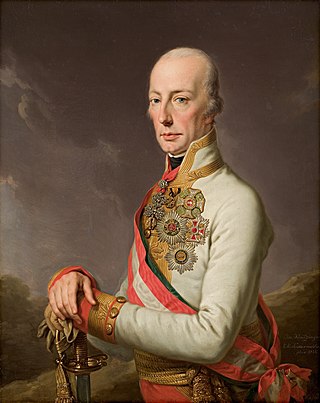
Francis II and I was the last Holy Roman Emperor as Francis II from 1792 to 1806, and the first Emperor of Austria as Francis I from 1804 to 1835. He was also King of Hungary, Croatia and Bohemia, and served as the first president of the German Confederation following its establishment in 1815.

Franz Joseph I or Francis Joseph I was Emperor of Austria, King of Hungary, and the ruler of the other states of the Habsburg monarchy from 2 December 1848 until his death in 1916. In the early part of his reign, his realms and territories were referred to as the Austrian Empire, but were reconstituted as the dual monarchy of the Austro-Hungarian Empire in 1867. From 1 May 1850 to 24 August 1866, he was also president of the German Confederation.

Charles I or Karl I was Emperor of Austria, King of Hungary, King of Croatia, King of Bohemia, and the last of the monarchs belonging to the House of Habsburg-Lorraine to rule over Austria-Hungary. The son of Archduke Otto of Austria and Princess Maria Josepha of Saxony, Charles became heir presumptive of Emperor Franz Joseph when his uncle Archduke Franz Ferdinand of Austria was assassinated in 1914. In 1911, he married Princess Zita of Bourbon-Parma. He is venerated in the Catholic Church, was beatified by Pope John Paul II on 3 October 2004, and is known to the Catholic Church as Blessed Karl of Austria.
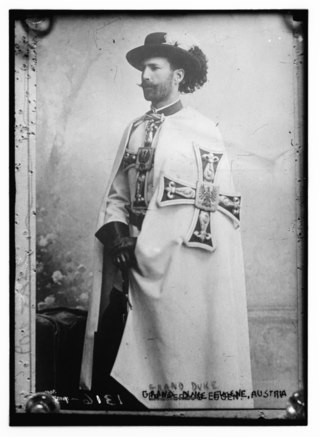
Archduke Eugen Ferdinand Pius Bernhard Felix Maria of Austria-Teschen was an Archduke of Austria and a Prince of Hungary and Bohemia. He was the last Grand Master of the Teutonic Order from the Habsburg dynasty.
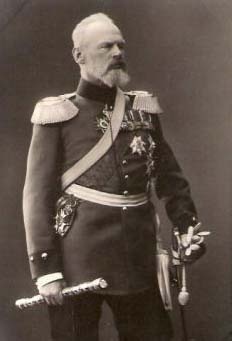
Prince Leopold of Bavaria was born in Munich, the second son of Prince Regent Luitpold of Bavaria (1821–1912) and his wife Archduchess Augusta of Austria (1825–1864). He was a Field Marshal (Generalfeldmarschall) who commanded German and Austro-Hungarian forces on the Eastern Front in World War I.

Frederick Augustus III was the last King of Saxony (1904–1918). Born in Dresden, Frederick Augustus was the eldest son of King George of Saxony and his wife, Maria Anna of Portugal.
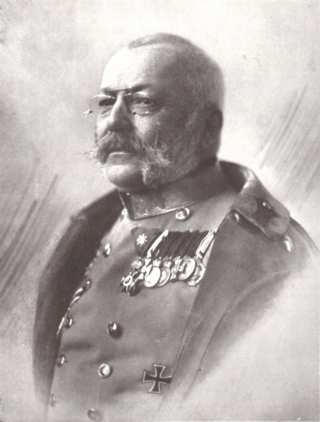
Archduke Friedrich, Duke of Teschen was a member of the House of Habsburg and the supreme commander of the Austro-Hungarian Army during World War I.

The Imperial Crypt, also called the Capuchin Crypt (Kapuzinergruft), is a burial chamber beneath the Capuchin Church and monastery in Vienna, Austria. It was founded in 1618 and dedicated in 1632, and located on the Neuer Markt square of the Innere Stadt, near the Hofburg Palace. Since 1633, the Imperial Crypt serves as the principal place of entombment for the members of the House of Habsburg. The bones of 145 Habsburg royalty, plus urns containing the hearts or cremated remains of four others, are here, including 12 emperors and 18 empresses. The visible 107 metal sarcophagi and five heart urns range in style from puritan plain to exuberant rococo. Some of the dozen resident Capuchin friars continue their customary role as the guardians and caretakers of the crypt, along with their other pastoral work in Vienna. The most recent entombment was in 2023.

Archduke Albrecht Friedrich Rudolf Dominik of Austria, Duke of Teschen, was an Austrian Habsburg general. He was the grandson of Emperor Leopold II and one of the chief military advisors of Emperor Francis Joseph I. As Inspector General for 36 years, he was an old-fashioned bureaucrat who largely controlled the Austro-Hungarian Army and delayed modernization. He was honored with the rank of Field Marshal in the armies of Austria-Hungary (1863) and Germany (1893).

The Military Order of Maria Theresa was the highest military honour of the Habsburg monarchy, Austrian Empire and Austro-Hungarian Empire.
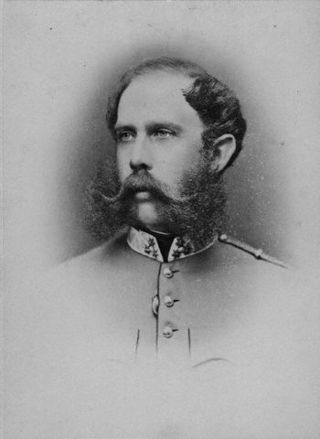
Archduke Karl Ludwig Josef Maria of Austria was the younger brother of both Franz Joseph I of Austria and Maximilian I of Mexico, and the father of Archduke Franz Ferdinand of Austria (1863–1914), whose assassination ignited World War I. His grandson was the last emperor of Austria, Charles I.
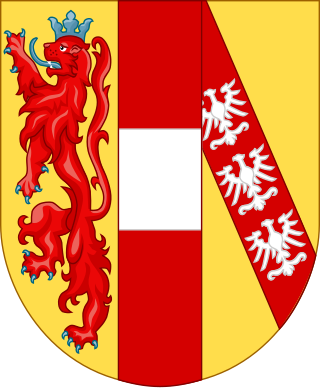
The House of Habsburg-Lorraine originated from the marriage in 1736 of Francis III, Duke of Lorraine and Bar, and Maria Theresa of Austria, later successively Queen of Bohemia, Queen of Hungary, Queen of Croatia and Archduchess of Austria. Its members are the legitimate surviving line of both the House of Habsburg and the House of Lorraine and inherit their patrimonial possessions from their female line of the House of Habsburg and from the male line of the House of Lorraine.

William, Prince of Hohenzollern was the eldest son of Leopold, Prince of Hohenzollern and Infanta Antónia of Portugal.

Archduke Charles Stephen Eugene Viktor Felix Maria of Austria was a member of the House of Habsburg, a Grand Admiral in the Austro-Hungarian Navy and candidate for the Polish crown.

The Order of Saint Stephen was an order of chivalry founded in 1764 by Maria Theresa. In 1938, Miklós Horthy took the rights and activities of Grand Master as Regent of Hungary. The name of the Order changed to the Royal Hungarian Order of Saint Stephen. The Order was terminated at the time of the proclamation of the Second Hungarian Republic in 1946. It was recreated in 2011 as the Hungarian Order of Saint Stephen, and to this day remains the highest order in Hungary.

Archduke Stephen Francis Victor was a member of the House of Habsburg-Lorraine and the last Palatine of Hungary, serving from 1847 to 1848.

Archduke Joseph Karl of Austria was a member of the House of Habsburg-Lorraine. He was the second son of Archduke Joseph, Palatine of Hungary and Duchess Maria Dorothea of Württemberg.

Prince Franz of Bavaria was a member of the Bavarian Royal House of Wittelsbach and a Major General in the Bavarian Army.

Archduke Hubert Salvator of Austria, Prince of Tuscany was a member of the Tuscan line of the House of Habsburg and Archduke of Austria, Prince of Tuscany by birth.
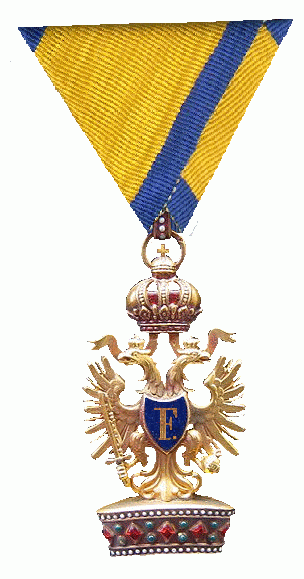
The Imperial Order of the Iron Crown was one of the highest orders of merit in the Austrian Empire and Austria-Hungary until 1918. It was founded in 1815 by Emperor Franz I of Austria as a re-establishment of the original Order of the Iron Crown, which previously had been an order of the Napoleonic Kingdom of Italy.
References
- ↑ "'Perfect' Archduke Joseph diamond sells for $21m". BBC News. 13 November 2012. Retrieved 17 November 2012.
- ↑ "A0002 - Kostanjevica - The Boroevic's throne". Pro Hereditate. Retrieved 7 July 2015.
- ↑ "A0003 - Kostanjevica - The monument-signpost near Lokvica". Pro Hereditate. Retrieved 7 July 2015.
- ↑ "Die amtliche Meldung über den Rücktritt" (in German). Neue Freie Presse, Morgenblatt. 1919-08-24. p. 2.
- ↑ "Genealogie des Allerhöchsten Herrscherhauses", Hof- und Staatshandbuch der Österreichisch-Ungarischen Monarchie, 1918, p. 15, retrieved 23 July 2020
- 1 2 3 4 "Ritter-Orden", Hof- und Staatshandbuch der Österreichisch-Ungarischen Monarchie, 1918, pp. 50, 52, 58, 82 , retrieved 23 July 2020
- ↑ "A Szent István Rend tagjai" Archived 22 December 2010 at the Wayback Machine
- ↑ "Real y distinguida orden de Carlos III", Guóa Oficial de España (in Spanish), 1930, p. 224, retrieved 21 March 2019
- ↑ The London Gazette, issue 28170, p. 6145
- ↑ "Foreign Pour le Mérite Awards: Foreign Awards During World War I". pourlemerite.org. Archived from the original on 31 October 2019. Retrieved 12 August 2020.
- ↑ Hof- und Staats-Handbuch des Königreich Bayern (1906), "Königliche Orden" p. 9
- Cunliffe-Owen, Marguerite. Keystone of Empire: Francis Joseph of Austria. New York: Harper, 1903.
- Gerő, András. Emperor Francis Joseph: King of the Hungarians. Boulder, Colo.: Social Science Monographs, 2001.
- Palmer, Alan. Twilight of the Habsburgs: The Life and Times of Emperor Francis Joseph. New York: Weidenfeld & Nicolson, 1995.
- Van der Kiste, John. Emperor Francis Joseph: Life, Death and the Fall of the Habsburg Empire. Stroud, England: Sutton, 2005.
- Schad, Martha,Kaiserin Elisabeth und ihre Töchter. München, Langen Müller, 1998